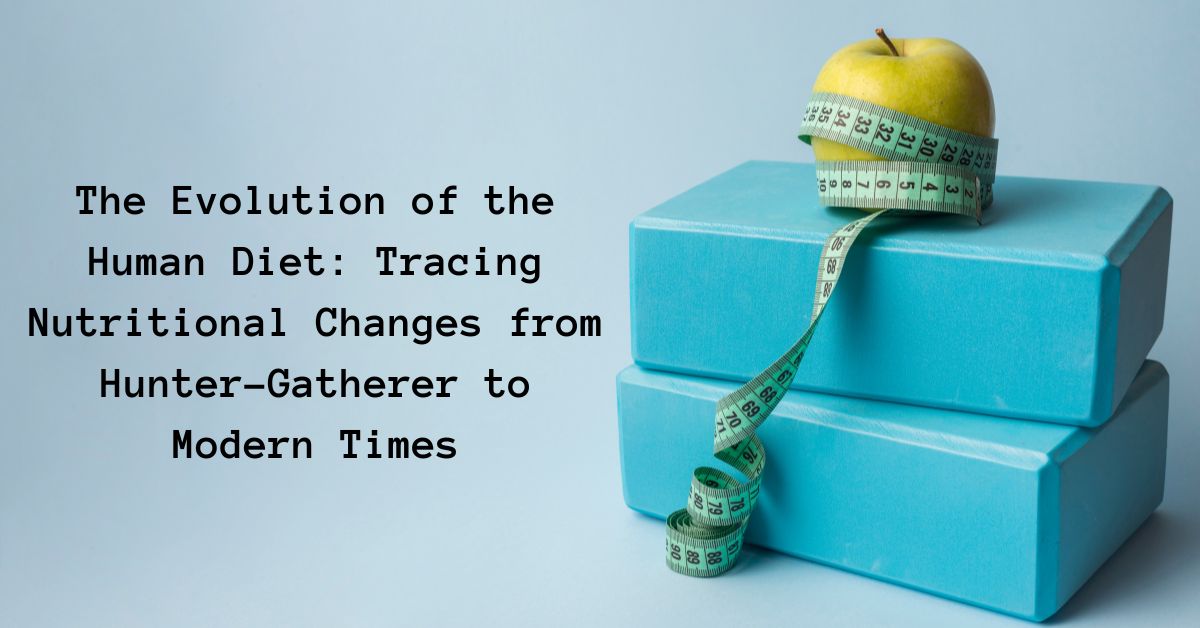The Evolution of the Human Diet: Tracing Nutritional Changes from Hunter-Gatherer to Modern Times , The evolution of the human diet has undergone significant changes from our hunter-gatherer ancestors to modern times. Early humans primarily relied on a diet of wild plants, lean meats, and seasonal foraged foods. This diet was rich in fiber, vitamins, and essential nutrients, promoting health and longevity. As societies transitioned to agriculture, our diet shifted towards cultivated crops and domesticated animals, introducing grains and dairy products.

The industrial revolution further transformed our diet by ushering in processed and convenience foods, high in sugars and unhealthy fats. These changes have led to the rise of diet-related health issues such as obesity and cardiovascular diseases. In recent decades, there has been a resurgence of interest in a more ancestral or “paleo” diet, emphasizing whole foods, lean proteins, and natural sources of nutrition.
Today, our diet varies widely, influenced by cultural, economic, and personal factors. The key challenge is to strike a balance between modern convenience and nutritional quality, aiming for a diet that combines elements of our hunter-gatherer past with contemporary knowledge. Achieving a diet rich in whole foods, vegetables, and lean proteins while minimizing processed and sugary items can help us maintain good health and well-being in our fast-paced modern world.
what did humans eat 10,000 years ago
Around 10,000 years ago, during the Neolithic period, humans underwent a significant dietary transition as they transitioned from a predominantly hunter-gatherer lifestyle to one centered around agriculture. This shift marked the advent of farming, with people in different regions cultivating various crops and domesticating animals.
In the Fertile Crescent, considered the cradle of agriculture, people began growing wheat, barley, and legumes, while in other regions, rice, maize, and potatoes were cultivated. The domestication of animals like goats, sheep, cattle, and pigs also became common. These developments enabled a more stable and reliable food supply.
This shift to agriculture allowed for the development of larger settled communities, leading to the emergence of early civilizations. However, this dietary change brought both advantages and challenges. While it provided a more consistent source of food, it also introduced new diseases due to closer contact with animals and a diet richer in grains. This shift towards agriculture profoundly impacted human diets, laying the
What are humans supposed to eat naturally
Human dietary needs are rooted in our evolutionary history as omnivores, capable of consuming a wide range of foods. Our natural diet is characterized by variety and balance. It comprises elements like:
- Fruits and Vegetables: A natural diet includes an abundance of fruits and vegetables, providing essential vitamins, minerals, fiber, and antioxidants. These plant-based foods are vital for good health.
- Lean Proteins: Our ancestors hunted and gathered lean meats, seafood, and eggs. Lean proteins supply essential amino acids, promoting muscle growth and overall well-being.
- Whole Grains: Consumption of whole grains like wheat, barley, and oats dates back thousands of years. They offer complex carbohydrates and fiber, providing sustained energy.
- Nuts and Seeds: These provide healthy fats, protein, and a range of essential nutrients. They were a valuable part of early human diets.
- Dairy (if tolerated): Some populations have developed lactase persistence, allowing them to consume dairy products. These offer calcium and other nutrients.
- Minimal Processed Foods: A natural diet avoids or minimizes heavily processed foods high in sugars, unhealthy fats, and additives. These foods can contribute to health issues when overconsumed.
While our evolutionary diet forms a foundation, individual variations due to genetics, culture, and personal preferences exist. What’s crucial is a balanced and mindful approach, focusing on fresh, whole foods, and minimizing processed items. Modern nutritional science helps tailor our diets to individual needs while keeping the essence of a natural, diverse, and balanced diet.
What early humans ate vs what we eat now
Early humans, as hunter-gatherers, consumed a diet that was fundamentally different from our modern diets. Their diet mainly consisted of:
- Wild Plants: Early humans foraged for a variety of wild plants, such as fruits, vegetables, nuts, and roots. These provided essential vitamins, minerals, and fiber.
- Lean Meats: Hunting provided lean sources of protein, including game animals and fish. These meats were rich in vital nutrients like iron and omega-3 fatty acids.
- Low Processed Foods: Their diet had minimal to no processed foods, refined sugars, or unhealthy fats, reducing the risk of diet-related diseases.
In contrast, modern diets have evolved due to agricultural, industrial, and technological advancements. We now consume:
- Processed Foods: Our diets are laden with heavily processed and convenience foods, often high in sugars, unhealthy fats, and additives.
- Grains and Dairy: Agriculture introduced grains like wheat and rice, along with dairy products. These foods have become dietary staples in many regions.
- Varied Protein Sources: In addition to animal protein, modern diets include a wide range of plant-based proteins, such as soy and legumes.
- Global Cuisines: Diverse cultural influences have expanded our palates, incorporating foods from around the world into our daily meals.
- Overeating: Modern diets frequently include excessive calorie intake, contributing to obesity and related health issues.
In summary, early human diets were simple, natural, and unprocessed, while modern diets are more diverse and convenient but often excessively processed. The challenge today is to strike a balance between our evolutionary dietary heritage and contemporary nutritional knowledge to promote health and well-being.
What was the food eaten by early humans
Early humans, as hunter-gatherers, had a diet primarily based on natural, unprocessed foods. Their food sources included:
- Wild Plants: Early humans foraged for a variety of wild plants such as fruits, vegetables, roots, tubers, and nuts. These plant-based foods were rich in essential vitamins, minerals, and dietary fiber.
- Lean Meats: Hunting played a crucial role in their diet. They consumed lean meats from game animals like deer, bison, and fish, providing them with high-quality protein, iron, and omega-3 fatty acids.
- Seafood: Near water sources, seafood was a significant part of their diet, contributing to their intake of protein, essential fatty acids, and micronutrients.
- Insects: Insects were another source of protein and nutrients, commonly consumed in various cultures around the world.
- Low Processing: Early humans had little to no access to processed foods, refined sugars, or unhealthy fats, resulting in a diet with lower levels of additives and preservatives.
The early human diet was diverse and largely unprocessed, reflecting a close connection to nature and an intuitive sense of nutrition. It was well-balanced, providing the necessary nutrients to support their active lifestyles. This dietary pattern was adapted to the environments and seasons they inhabited and played a crucial role in their survival and evolution.
Why did humans start eating meat
The consumption of meat by early humans marked a pivotal point in our evolutionary history, driven by several factors.
- Evolutionary Adaptation: The transition to a meat-based diet was influenced by natural selection. Early hominids adapted to a diet that included animal protein because it provided essential nutrients like high-quality protein, iron, and vitamin B12. These nutrients were vital for brain development, physical growth, and overall health.
- Increased Energy: Meat is a dense source of calories and nutrients. Early humans, who had limited access to high-energy plant foods, found meat to be an efficient way to obtain the energy necessary for their physically demanding lifestyles, including hunting and gathering.
- Improved Nutrition: Meat consumption was beneficial in regions where plant-based food sources were scarce, especially during colder seasons. It supplemented their diet with nutrients they might not otherwise obtain.
- Social Cooperation: The act of hunting and sharing meat fostered social cooperation and community bonding. This cooperation contributed to the survival and success of early human groups.
- Tool Use: Early humans developed tools like spears and knives, enabling them to more effectively hunt and process meat.
The inclusion of meat in the diet was a significant evolutionary advantage, contributing to the development of our species. It not only ensured the availability of vital nutrients but also played a role in shaping human social structures and behaviors. This shift towards meat consumption is considered a key factor in the success and development of Homo sapiens.
Did humans eat meat or plants first
The debate regarding whether early humans primarily ate meat or plants first is a complex one, but evidence suggests that they initially had a plant-based diet before incorporating meat into their nutrition. This shift reflects our ancestors’ evolutionary adaptation and dietary versatility.
Early hominids, such as Australopithecus, had a diet primarily based on plant materials. Their dentition, digestive systems, and the prevalence of dental features associated with plant eating support this. These early hominids had a preference for fruits, leaves, roots, and other plant-based foods.
As our ancestors evolved and developed tools, such as the ability to make stone tools for cutting and processing meat, they began to incorporate meat into their diet. Homo habilis, one of the earliest members of our genus, is believed to have been among the first to do so. The inclusion of meat provided a concentrated source of essential nutrients like protein, fat, and key vitamins and minerals.
So, while early humans likely started with a plant-based diet due to their anatomical and ecological adaptations, the consumption of meat gradually became more significant in their nutritional repertoire, shaping our evolutionary history as omnivores with the ability to consume both plant and animal foods.
what did humans eat 50,000 years ago
Around 50,000 years ago, our early human ancestors were predominantly hunter-gatherers, and their diet was shaped by the resources available to them in the environments they inhabited. Their food sources included:
Wild Game: Early humans were skilled hunters, relying on game animals such as bison, deer, and various smaller mammals. The meat provided them with essential protein, fat, and nutrients necessary for survival.
Fish and Seafood: Depending on their proximity to water bodies, seafood became a valuable part of their diet, offering additional sources of protein and healthy fats.
Foraged Plants: These early humans gathered a wide variety of wild plants, including fruits, nuts, vegetables, and tubers. These plant-based foods provided essential vitamins, minerals, and dietary fiber.
Insects: Insects, rich in protein and other nutrients, were often included in their diets. They offered a readily available source of nutrition.
Seeds and Nuts: Depending on the region, the gathering of seeds, nuts, and edible plant parts contributed to their diet.
Their diet was diverse, largely unprocessed, and nutritionally balanced, reflecting their close connection to nature. The foods they consumed were seasonally dependent and varied by geographic location, highlighting their adaptability and resourcefulness as hunter-gatherers. This diet, rich in both animal and plant foods, played a significant role in shaping human evolution and survival.
